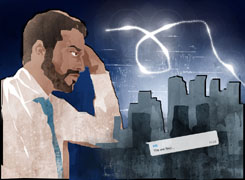How can I manage my financial struggles with no job and mounting expenses?
Ramalingam Kalirajan |10872 Answers |Ask -Follow
Mutual Funds, Financial Planning Expert - Answered on Oct 23, 2024
He has an MBA in finance from the University of Madras and is a certified financial planner.
He is the director and chief financial planner at Holistic Investment, a Chennai-based firm that offers financial planning and wealth management advice.... more

I took a flat last year and at that time my business was running nicely but soon i ran into losses and forcefully i closed my busines and from april 2024 i have no work and very less capital,i have to pay emi and my kids school fees and other expenses which is amounting to 1lakh every month idk how should i come out of this
Prioritize Your Expenses
EMI and Essential Bills: Your home loan EMI and your children's school fees are non-negotiable expenses. These should be your top priority.
Other Monthly Expenses: Review your household spending. Identify any discretionary expenses that can be cut down. Reducing non-essential spending temporarily can free up some money for necessary payments.
Family Support: If possible, consider seeking short-term financial support from family members. This can help you bridge the gap during this critical period.
Utilize Your Existing Assets
1. Liquidate a Portion of Your Fixed Deposits
You have Rs. 1.5 crore in fixed deposits. This is a significant sum. You could consider breaking a portion of these FDs to meet your immediate needs. While breaking an FD may result in a loss of interest, it will provide the liquidity needed to manage your expenses.
Action Step: Break only the amount you need for 6 months to a year of expenses. This will give you breathing space and reduce financial stress while you find new sources of income.
2. Leverage Your Mutual Fund Investments
You have Rs. 40 lakhs in mutual funds. You might consider redeeming a portion of this to create a cash buffer.
Action Step: Withdraw from the mutual funds that have performed well and where you can incur the least loss due to market conditions. Ensure you leave some investments intact for long-term growth.
3. Emergency Loan Against Investments
Instead of redeeming your mutual funds or fixed deposits, you can explore taking a loan against them. Many banks offer loans against mutual funds or fixed deposits at reasonable interest rates.
Action Step: Taking a loan against your investments will allow you to get liquidity without selling your assets. This can help manage the cash crunch without disturbing long-term savings.
Plan for Income Generation
1. Temporary or Freelance Work
While you may be facing difficulty with your business, consider temporary or freelance work that matches your skillset. Look into short-term projects or consultancy opportunities that can provide you with an immediate source of income.
Action Step: Update your network and look for opportunities that match your expertise, even if they are not as lucrative as your business used to be. A steady income will help you meet your EMI and household expenses.
2. Rent Out Part of Your Flat
If your flat is large or you have extra space, consider renting out a part of it. This can provide a steady stream of income.
Action Step: Explore if there is a demand for rental housing in your area. This could help generate monthly cash flow without you needing to sell any assets.
EMI Restructuring
1. Negotiate with Your Bank
Given your current financial hardship, you can approach your bank for EMI restructuring or loan moratorium. Many banks offer relief in terms of reducing the EMI amount or extending the loan tenure for customers facing financial difficulties.
Action Step: Speak to your bank about your situation. Ask for a moratorium on EMI payments for a few months or request a temporary reduction in EMI amounts.
2. Consider Refinancing Your Home Loan
Another option is to explore home loan refinancing. Refinancing could reduce your EMI burden by securing a lower interest rate.
Action Step: Contact your bank or other financial institutions to explore whether you can refinance the loan at a lower rate.
Education Fee Management
1. Request for School Fee Payment Flexibility
If paying the school fees in one go is challenging, approach your children’s school and explain your situation. Many schools are open to payment plans where fees can be paid in installments.
Action Step: Talk to the school administration about the possibility of extending fee payments or reducing the amount temporarily based on your financial situation.
Focus on Emotional Well-being
This period can be emotionally draining, especially with the pressure of meeting financial obligations. It’s important to stay positive and seek support from family and friends during this tough time. Sometimes sharing the burden with trusted people can help you think more clearly.
Final Insights
You have several options to manage this financial crunch:
Use existing assets: Liquidate or borrow against your fixed deposits and mutual funds.
Look for income: Explore temporary work or renting out part of your property for additional income.
Reduce EMI burden: Negotiate with your bank for EMI relief, and consider refinancing your home loan.
Communicate with the school: Request flexibility in fee payments.
Stay focused and take it step by step. With the right approach, you will be able to manage these challenges and regain financial stability.
Best Regards,
K. Ramalingam, MBA, CFP,
Chief Financial Planner,
www.holisticinvestment.in
https://www.youtube.com/@HolisticInvestment
You may like to see similar questions and answers below
Baqar Iftikhar Naqvi | Answer |Ask -Follow
Start-up Mentor - Answered on Sep 27, 2023
Nitin Narkhede | Answer |Ask -Follow
MF, PF Expert - Answered on Jul 02, 2025
Radheshyam Zanwar |6735 Answers |Ask -Follow
MHT-CET, IIT-JEE, NEET-UG Expert - Answered on Dec 06, 2025
Dr Nagarajan J S K |2576 Answers |Ask -Follow
NEET, Medical, Pharmacy Careers - Answered on Dec 06, 2025
Mihir Tanna |1090 Answers |Ask -Follow
Tax Expert - Answered on Dec 06, 2025
Ramalingam Kalirajan |10872 Answers |Ask -Follow
Mutual Funds, Financial Planning Expert - Answered on Dec 06, 2025
Radheshyam Zanwar |6735 Answers |Ask -Follow
MHT-CET, IIT-JEE, NEET-UG Expert - Answered on Dec 06, 2025
Radheshyam Zanwar |6735 Answers |Ask -Follow
MHT-CET, IIT-JEE, NEET-UG Expert - Answered on Dec 06, 2025
Radheshyam Zanwar |6735 Answers |Ask -Follow
MHT-CET, IIT-JEE, NEET-UG Expert - Answered on Dec 06, 2025
Dr Dipankar Dutta |1837 Answers |Ask -Follow
Tech Careers and Skill Development Expert - Answered on Dec 05, 2025
Dr Shyam Jamalabad |108 Answers |Ask -Follow
Dentist - Answered on Dec 05, 2025
Dr Shyam Jamalabad |108 Answers |Ask -Follow
Dentist - Answered on Dec 05, 2025


























